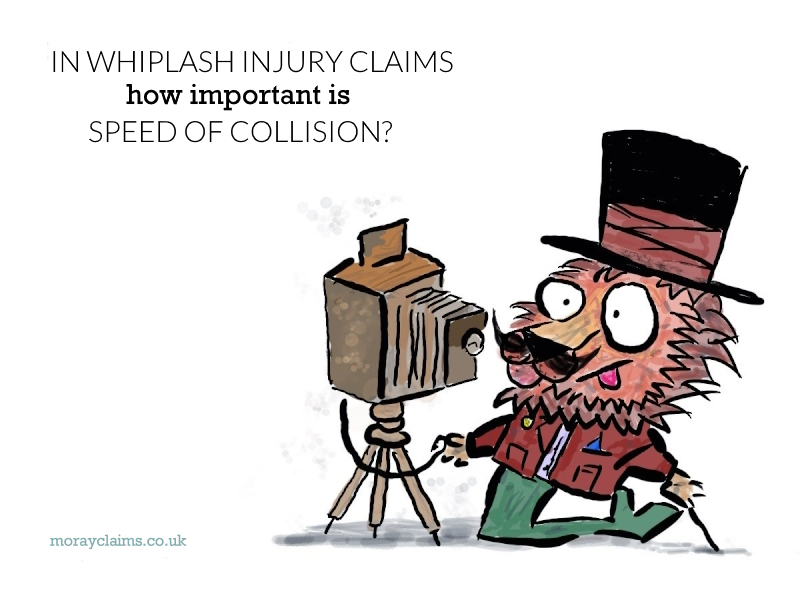
By definition, whiplash injuries are caused by low velocity impacts.
The perpetual difficulty we have in describing whiplash injuries stems from the fact that there is, by definition, no structural pathology (i.e. nothing that can be independently verified by x-rays or other scans)
They say that whiplash-associated disorders remain ‘a diagnosis of exclusion’. In other words, if you seem to be dealing with ‘appropriate’ symptoms and nothing else would explain them, “whiplash” is your diagnosis because you have excluded all other possibilities.
What is the mechanism of a whiplash injury?
The mechanism of a whiplash injury involves the initial acceleration of the vehicle occupant due to force being transmitted through the vehicle in which they are seated – typically, a rear-end shunt of their vehicle.
This results in the occupant to moving forward.
In moving forward, the occupant’s head and upper cervical spine (neck) lags behind very slightly compared to the movement of their body and lower spine.
Secondary deceleration of their body occurs due to their seat belt activating and pulling them backwards. But the head lags behind, as it is not restrained by the seat belt. The extent of the time lag is around 500 milliseconds (i.e. half a second).
The bodily structures relevant to whiplash are the skeleton, intra-vertebral discs, ligaments and muscles.
If muscles were to be taken out of the equation, the other structures mentioned – in the sub-heading above – cannot support the head. Muscular tone is critical to maintaining the head in the upright position.
Muscles are the focus, with whiplash.
The primary physical problem is caused by the sudden contraction of muscles. Secondary injury can be caused to the ligaments but the principal injury is a muscle-type strain.
Where the occupant is restrained by a seat belt the upper part of the body is relatively well protected – with little movement occurring there – but the neck and head are, in comparison, free to move.
In around 9 out of 10 cases of whiplash injury, the injured vehicle occupant experiences an onset of symptoms within 24 hours.
Typically, there is a gradual worsening of symptoms over a short period of time.
As mentioned above, whiplash injuries occur predominantly in low velocity collisions. It is unusual for an individual to complain of whiplash where severe injuries have been suffered.
What factors will affect the likelihood of a person developing symptoms and their severity?
Various factors can have a bearing on the susceptibility of a person to develop symptoms after, say, a rear-end shunt. For example:
- a pre-existing neck problem(including cervical spondylosis) and/or psychological conditions,
- gender (the risk of developing symptoms is greater in females),
- age (the risk of developing symptoms increases in middle age and reduces as we get older), and
- other biosocial factors.
Severity of injury is unrelated to the mechanism of the accident.
In other words, you cannot predict the severity of injury a person will sustain (if any) based on, say, the speed of impact between vehicles.
The severity of consequences of a vehicle impact is unique to the particular person in any given situation.
The speed of impact in itself is of relatively low importance in determining the severity of symptoms which someone develops.
Research studies have tested the effects of rear impacts on vehicle occupants at speeds as low as 2.5mph.
Even where their vehicle did not sustain any damage, as many as one in three of these occupants reported short-term whiplash-type symptoms.
There is no evidence of any lower speed limit below which whiplash injuries cannot be sustained. Indeed, given the number of relevant external factors in play (quite apart from the unique characteristics of the individual vehicle occupant, in addition) there is thought to be little or no point in asking what minimum speed is necessary to cause symptoms.
You are no more or less likely to suffer injury depending on whether you are the driver or a passenger in the affected vehicle.
How we can help
Please get in touch with us if you have any questions or comments arising from this article about how whiplash injuries tend to occur at low velocities. The speed of collision can be surprisingly low and yet still cause injury of this type.
If you have any questions arising from this article, please do not hesitate to contact us. Read THIS article, if you want to understand more about what will actually happen if you get in touch with us about making a personal injury compensation claim.
If it turns out that we are not the best people to help you directly, we’ll do our best to suggest a suitable alternative specialist legal adviser (or explain the best way to find one).
Our main aim is to help people in Moray to claim fair and full compensation for personal injury in such a way that it costs you nothing, whether your claim succeeds or not. We are specialist, accredited solicitors – at Grigor & Young LLP, Elgin.
You can call us on 01343 544077 or you can send us a Free Online Enquiry.